
Modern Organocopper Chemistry
.pdf
328 10 Mechanisms of Copper-mediated Addition and Substitution Reactions
accelerating e ects of BF3 Et2O in the latter reactions indicate the importance of substrate activation (see Sect. 10.6.1) [97].
The alkylation of an alkyl bromide or tosylate, or of an epoxide, with organocuprates takes places with 100% inversion of the stereochemistry at the electrophilic carbon, as shown below (Eq. 10.10) [22, 98]. The magnitudes of primary and secondary kinetic isotope e ects in the reaction between Me2CuLi LiI PBu3 and CH3I strongly suggested that the rate-determining step of the reaction is the SN2 displacement stage [99]. Reactions between R2CuLi and alkyl halides, aryl halides, and alkyl tosylates have been shown to be first order in the concentration of the R2CuLi dimer and the alkylating reagent [97, 100, 101]. RCu and RCu(PBu3) do not react with epoxides [96]. Alkylation reactions of R2CuLi do not take place in the presence of a crown ether, demonstrating the importance of a Lewis acidic LiX component associated with the cuprate moiety. On the other hand, moderately basic and polar THF is a better solvent than diethylether for alkylation [22].
ð10:10Þ
Two mechanistic possibilities for the substitution reactions have been suggested (Scheme 10.8). The first assumes simple SN2 substitution of the R anion group. The second assumes rate-determining displacement of the leaving group with copper bearing a formal negative charge, and subsequent formation of a trialkylcopper(III) intermediate [82]. This then undergoes reductive elimination to give the cross-coupling product. Though the second mechanism may look pleasing enough to a copper specialist, it leaves a few important questions unanswered; namely the role of the lithium cation, the relative magnitude of k1 and k2, and, among other things, the reason why exclusive production of a cross-coupled product RaR1 by way of a symmetrical R2(R1)CuIII intermediate is always observed.
Scheme 10.8. Two proposed alkylation reaction mechanisms.
The proposed participation of a CuIII intermediate is based on an analogy with the chemistry of lithium diorganoaurate(I), R2AuILi [102, 103]. Recent crystallographic data for CuIII species [104] have further supported the similarity between AuIII and CuIII [105].

10.4 Substitution Reactions on Carbon Atoms 329
10.4.2
SN20 Allylation Reactions
Cuprates react rapidly with allylic halides (or acetates) [17, 23], propargyl halides (or acetates) [106–108], and vinyloxiranes, often with SN20 regioselectivity (Scheme 10.9) [17]. The reaction takes place with anti stereochemistry (with respect to the leaving group), while syn substitution occurs when an allylic carbamate is employed as the substrate [109].
Scheme 10.9. Anti-SN20 Allylation reaction with competing SN2 reaction pathway. X ¼ halogen, OAc, OP(O)Y2.
Reactions of R2CuLi tend to give mixtures of SN2 and SN20 products, which it has been suggested is due to the involvement of regioisomeric s-allylic CuIII species, shown bracketed in Scheme 10.9 [106, 110]. Studies on substituent e ects in competitive reactions suggested that the rate-determining stage might involve a two-electron transfer from copper to the allylic substrate [107]. The SN2 selectivity of the reaction of Bu2Cu(X)(MgBr)2 is higher with X ¼ I and OTs than with X ¼ Cl and Br, and also higher in ether than in THF [111]. A combination of an organocopper compound and a Lewis acid, such as RCu BF3 [5], R2CuLi ZnCl2 [112], R2CuLi TiIV [113], or R2CuLi AlCl3 [114], greatly enhances the SN20 selectivity. Cu(I)-mediated reactions of organozinc species also a ord high SN20 selectivities [112, 115–117]. NMR studies on R2CuLi ZnCl2 and R2CuLi TiIV reagents showed only rapid transmetalation from Cu to Zn or Ti, giving little information on any putative Cu/Zn or Cu/Ti mixed species. Scant information is available for the transition state. The stereoselectivity of the SN20 reaction of d-substituted allylic halide of the SN2 reaction suggested that the transition state geometry for the delivery of an R group from copper has a four-centered character, as shown below (Eq. 10.11) [112]. This conjecture was supported by theoretical comparison between the TS geometries of olefin carbolithiation and those of acetylene carbocupration (cf. Scheme 10.7) [91].
ð10:11Þ
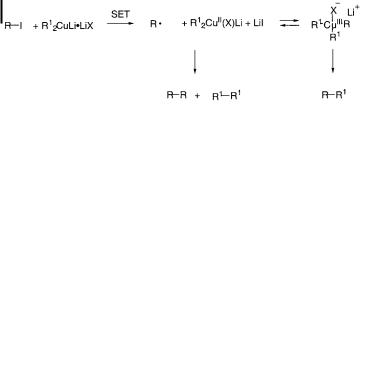
33010 Mechanisms of Copper-mediated Addition and Substitution Reactions
10.4.3
Radical Substitution Reaction Mechanisms
The SET mechanism has been suggested for the alkylation reaction of secondary alkyl iodides, in which the substitution reaction takes place in stereorandom fashion [22, 118]. The reaction between triphenylmethyl bromide and Me2CuLi generated an ESR-active triphenylmethyl radical, although this may be regarded as a special case [119]. On the basis of trapping experiments using styrene, it was concluded that dialkylcuprate substitution reactions of primary and secondary alkyl iodides may proceed by an SET mechanism, whereas those of primary and secondary bromides do not [120]. This reaction also produces self-coupling products, which is consistent with radicals being involved (Scheme 10.10). The intramolecular cyclization of an olefinic iodide in the presence of an organocopper reagent has been taken as possible but not conclusive evidence of SET [120].
Scheme 10.10. Radical mechanism in alkylation reactions with alkyl halides.
10.4.4
Catalytic Substitution Reactions
Kinetic experiments have been performed on a copper-catalyzed substitution reaction of an alkyl halide, and the reaction rate was found to be first order in the copper salt, the halide, and the Grignard reagent [121]. This was not the case for a silver-catalyzed substitution reaction with a primary bromide, in which the reaction was found to be zero order in Grignard reagents [122]. A radical mechanism might be operative in the case of the silver-catalyzed reaction, whereas a nucleophilic substitution mechanism is suggested in the copper-catalyzed reaction [122]. The same behavior was also observed in the stoichiometric conjugate addition (Sect. 10.2.1) [30].
10.4.5
Theoretically Based Alkylation Reaction Pathways
Alkylation reactions reveal a mechanistic aspect of the cuprate reactions di erent from that of addition reactions. Theoretical analyses of reactions of alkyl halides (MeI and MeBr) [123, 124] and epoxides (ethylene oxide and cyclohexene oxide) [124] with lithium cuprate clusters (Me2CuLi dimer or Me2CuLi LiCl, Scheme 10.11) resolved long-standing questions on the mechanism of the alkylation reaction. Density functional calculations showed that the rate-determining step of the

10.4 Substitution Reactions on Carbon Atoms 331
Scheme 10.11. Reaction between R2CuLi LiX and an alkylating agent R1Z. Solvent coordinated to lithium atoms is omitted.
alkylation reaction (TSsb) is the substitution of the CaBr bond with an incoming MeaCu s-bond. The linear 3dz2 orbital of copper acts as the nucleophile here, as shown by the LMO in Fig. 10.4. The computed and experimental kinetic isotope e ects for the reaction of methyl iodide showed good agreement with each other, supporting this conclusion. It is notable that it is again possible to identify an open cluster structure in TSsb, with the lithium atom electrophilically activating the leaving group. A trialkylcopper(III) intermediate (INT) may form after the rate-
Fig. 10.4. Localized transition structure molecular orbital in the SN2 reaction between Me2CuLi LiCl and MeBr.

332 10 Mechanisms of Copper-mediated Addition and Substitution Reactions
determining, halide displacement step but only as an unstable transient species INT1 or INT2 (Scheme 10.11). These are trialkylcopper(III) complexes of T-shape geometry, with the fourth ligand (solvent of a halide) making the square planar structure [82]. The trans relationship of the two alkyl groups (R) is assured by the linear geometry of the cuprate moiety in the transition state TSsb, which guarantees cross-coupling between R and R1 in TScc. Interestingly, this mechanism is a hybrid of the two previous proposals shown in Scheme 10.8.
A similar reaction pathway was found for the SN2 substitution of an epoxide with a lithium cuprate cluster [124]. In contrast to that in the MeBr reaction, the stereochemistry of the electrophilic carbon center is already inverted in the transition state, providing the reason for the preferred ‘‘trans-diaxial epoxide-opening’’ widely observed in synthetic studies. The TS for the SN2 reaction of cyclohexene oxide is shown in Eq. 10.12.
ð10:12Þ
10.6
Other Issues
10.6.1
Counter-cation Lewis Acid E ects
For all major categories of lithium cuprate reactions, it has been shown that addition of a crown ether results in significant retardation [79, 94, 125]. In addition to this, sodium cuprates are much inferior to lithium cuprates for conjugate addition [126]. BF3 Et2O, on the other hand, accelerates conjugate additions [31] and alkylations of epoxides and aziridines [97, 127]. In allylation chemistry, zinc-based [128], titanium-based [113], and aluminum-based [114] organocopper reagents show much higher SN20 selectivities than lithium cuprate does. The Lewis acidities of cuprate counter-cations are undoubtedly important, but their mechanistic roles still need further investigation (Eq. 10.7).
Recent theoretical studies of reductive elimination from Me3Cu S in the presence of BF3 suggest that reaction rate of the conjugate addition can increase if one of the Me groups is detached from the copper(III) to bind with a boron atom (Scheme 10.12) [129].
The origin of the acceleration produced by BF3 in epoxide alkylation reactions has been examined theoretically [124]. A plausible pathway for BF3 participation in the epoxide-opening is shown in Fig. 10.5. An epoxide/BF3 complex CP1 may encounter the cuprate cluster to form a ternary complex CP2, or such a complex may
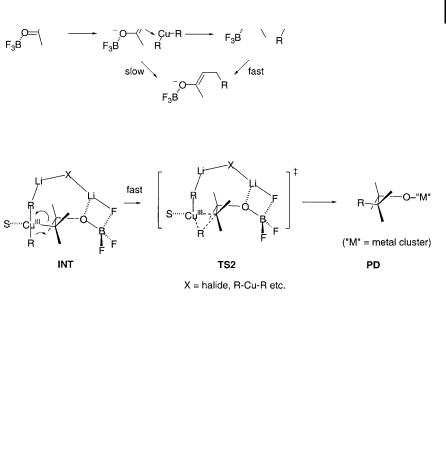
10.6 Other Issues 333
Scheme 10.12. Proposed mechanism of BF3 activation in the conjugate addition.
Fig. 10.5. Mechanism for the acceleration of an epoxide alkylation reaction by BF3.
also be formed from a cuprate/BF3 complex and the epoxide. Displacement to TS (TS1), followed by the formation of a Cu(III) intermediate (INT), gives the alkylation product PD. The cooperative interaction of BF3 fluorine and boron atoms with the cuprate and epoxide system is responsible for the acceleration and stabilization of products. The activation energy is reduced by ca. 10 kcal mol 1 compared to the process in the absence of BF3.
10.6.2
Me3SiCl Acceleration
Since Nakamura and Kuwajima’s initial discovery in 1984 [130], Me3SiCl has become a standard reagent for acceleration of conjugate additions. The e ect was first reported for copper-catalyzed conjugate additions of the zinc homoenolate of propionic acid esters, as shown in Scheme 10.13, and utilized in a total synthesis of cortisone [131]. Application to Grignard-based catalytic reagents and stoichiometric lithium diorganocuprate(I) followed [132]. Acceleration of conjugate additions and
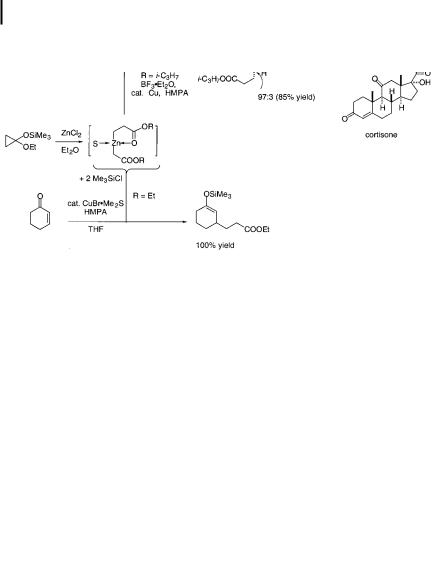
334 10 Mechanisms of Copper-mediated Addition and Substitution Reactions
modification of their selectivities by means of silylating agents are now well established [132].
Scheme 10.13. Me3SiCland BF3-accelerated catalytic conjugate addition and a cortisone synthesis.
Me3SiCl also a ects the stereoselectivity of 1,2-additions to carbonyl compounds [133]. With the aid of suitable activators, these mildly reactive reagents show selectivities unattainable by the conventional reagents, as illustrated below for Me3SiCldependent chemoselectivity (Eq. 10.13) [134].
ð10:13Þ
Considerable mechanistic discussion has appeared in the literature [135]. One argument assumes simple Lewis acid activation of the starting enone with Me3SiCl [136] (A in Scheme 10.14), although it is supported neither by experiment nor by theory [137]. On the contrary, Me3SiCl has indeed been shown to be Lewis acidic but rather to act as a base toward the lithium atom in the lithium cuprate cluster [135a] (C in Scheme 10.14). The second proposal, by Corey [73], which takes into account an inner sphere electron-transfer hypothesis, assumes in situ trapping of an enolate-like intermediate by the silylating agents, making the process irreversible (B in Scheme 10.14). The third and most recent proposal assumes theoretical
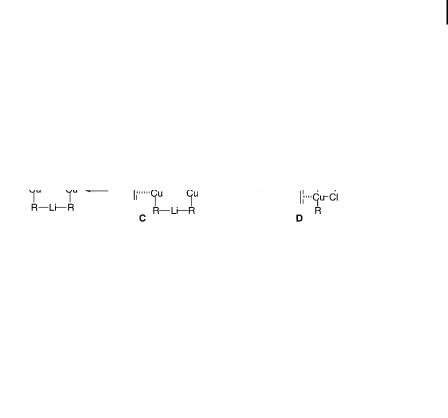
10.6 Other Issues 335
justification for chloride coordination to copper (D in Scheme 10.14) [135b]. The magnitude of such coordination, however, was recently shown to be very small [129]. While these proposals failed to provide a direct answer to the mechanism of Me3SiCl acceleration, the positive correlation between the silylating power of the reagent and the magnitude of rate acceleration [138] strongly suggests that the ratedetermining step of the reaction is the silylation step rather than the CaC bondforming step. Recent studies of kinetic isotope e ects by Singleton fully supported this observation [139]. Mechanistic data – such as reaction rate, stereochemistry, and theoretical analysis – are still awaited, however.
Scheme 10.14. Various proposed mechanisms for Me3SiCl acceleration of conjugate additions to enones (X ¼ Me3SiCl).
10.6.3
Dummy Ligands
A synthetic problem associated with the use of homocuprates R2Cu is that the reagent can transfer only one of the two possibly precious R ligands to the target electrophile (Eþ, for example, to a; b-unsaturated carbonyl compounds), with one R ligand being lost as an unreactive RCu species. The introduction in 1972 of mixed organocuprates [RCu(X)] [140], in which the X group acts as a nontransferable dummy ligand, provided the first general solution to this problem (Eq. 10.14). Typical dummy ligands include alkynyl [141], cyano [142], phenylthio [143], dialkylamino, and phosphino groups (Chapt. 3) [143, 144]. The selectivity of ligand transfer was considered to be a function of the ligand-ligand coupling process in an intermediate bearing three ligands: R, X and E. A widely accepted hypothesis was that an X group forming a stronger CuaX bond acts as a better dummy ligand (resisting transfer). While this hypothesis has successfully been applied to the design of dummy ligands, recent theoretical studies by Nakamura revealed an entirely di erent controlling factor in dummy ligand chemistry [145].
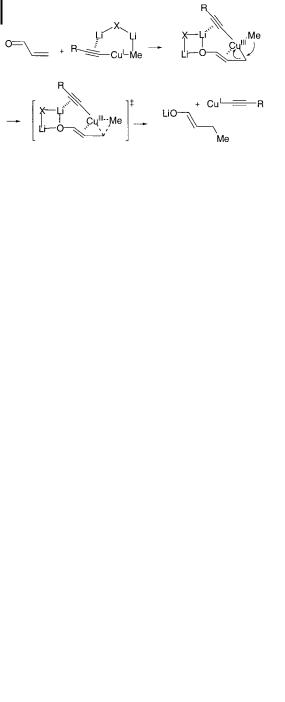
336 10 Mechanisms of Copper-mediated Addition and Substitution Reactions
ð10:14Þ
The recognition of the importance of cluster structure has resulted in a new understanding of the role of a dummy ligand (Y) in the chemistry of mixed cuprates MeCu(Y)Li [145]. As shown in Scheme 10.15 for the case of Y ¼ alkynyl, the
Scheme 10.15. Dummy ligands: selective transfer of the methyl (or alkyl, alkenyl, aryl) group in preference to transfer of the alkynyl group.
transfer of the methyl group is overwhelmingly favored over the transfer of the alkynyl group. This is because the alkynyl group acts as a tight bridge between CuIII and Liþ (Fig. 10.6). In other words, the alkynyl dummy group simultaneously binds to Cu and Li atoms (strong electrostatic interaction between the Li and the alkynyl group), and so remains on the copper atom. By default, the much less effective bridging organic ligand is transferred to the enone substrate. This runs
Fig. 10.6. 3D structure of the open complex between acrolein and Me(ethynyl)CuLi LiCl, with Me2O coordinated to each lithium atom (B3LYP/631A). Bond lengths are in a˚ngstroms.

10.6 Other Issues 337
contrary to the conventional hypothesis that the Y group forming a stronger CuaY bond acts as a better dummy ligand (resisting transfer), and has provided an further illustration of the critical roles of cluster structures in organocopper chemistry.
10.6.4
The ‘‘Higher Order’’ Cuprate Controversy
Organocopper(I) species bearing three anionic groups, ([R3Cu]2 ), are termed ‘‘higher order’’ cuprates [146, 147]. For purposes of di erentiation, conventional cuprate(I) species (R2Cu ) may be referred to as ‘‘lower order’’ cuprates. Whether or not a ‘‘higher order cyanocuprate (R2Cu(CN)Li2)’’, bearing two carbanionic residues and a cyanide anion on copper, exists as a stable species has been the subject of controversy (Eq. 10.15). This controversy has also spawned numerous mechanistic and structural studies on cuprates in general.
ð10:15Þ
It was reported in the 1970s that a ‘‘higher order’’ cuprate reagent, prepared by the use of more than two equivalents of an alkyllithium reagent with a copper(I) salt, was more reactive [20, 146] and more selective than ordinary cuprates [148]. Using NMR and cryoscopy, Ashby showed that species that could be regarded as higher order cuprates were formed [149]. Bertz demonstrated the presence of a triply coordinated Cu(I) complex ([R3Cu]2 ) for the first time, by solution NMR studies [150], while Power demonstrated the existence of a triply coordinated cuprate [Ph5Cu2Li3(SMe2)4] in the crystalline state [151, 152].
Lipshutz reported in 1981 that reagents formed by addition of two equivalents of RLi to CuCN give higher yields than the corresponding Gilman cuprates (R2CuLi) or lower order cyanocuprates (RCu(CN)Li), and described them as ‘‘R2Cu(CN)Li2’’ to imply a triply coordinated structure [147]. With the aid of 13C, 6Li, and 15N NMR data [153], Bertz was able to point out that cyanide was not attached to copper(I) in the Lipshutz mix, and started the controversy [154, 155]. Physical measurements by Penner-Hahn [156] and Lipshutz [157], and theoretical studies by Snyder [158], Penner-Hahn, and Frenking [159] contributed much to the discussion. All the crystallographic data for cyanocuprates of ‘‘higher-order stoichiometry’’ recently reported by Boche [160] and van Koten [161] indicated that the cyanide anion is coordinated to lithium and not to copper. Evidence along the same lines was found in sodium and potassium derivatives [162]. The consensus, therefore, after many years of studies, is that triply coordinated [Cu(CN)R2]2 is not a stable structure in ethereal solution [153, 163–165]. Despite this conclusion, the Lipshutz mixed reagent still remains the one of choice in many synthetic transformations, and the presence of a triply coordinated cuprate(I) dianion was recently indicated by 13Ca13CN carbon coupling in cyanostannylvinylcuprate(I) dianion in a THF/ HMPA mixture [166]. In addition, the cyanide anion finds its way onto copper at the end of the reaction, forming RCu(CN)Li, while it is not known when the
